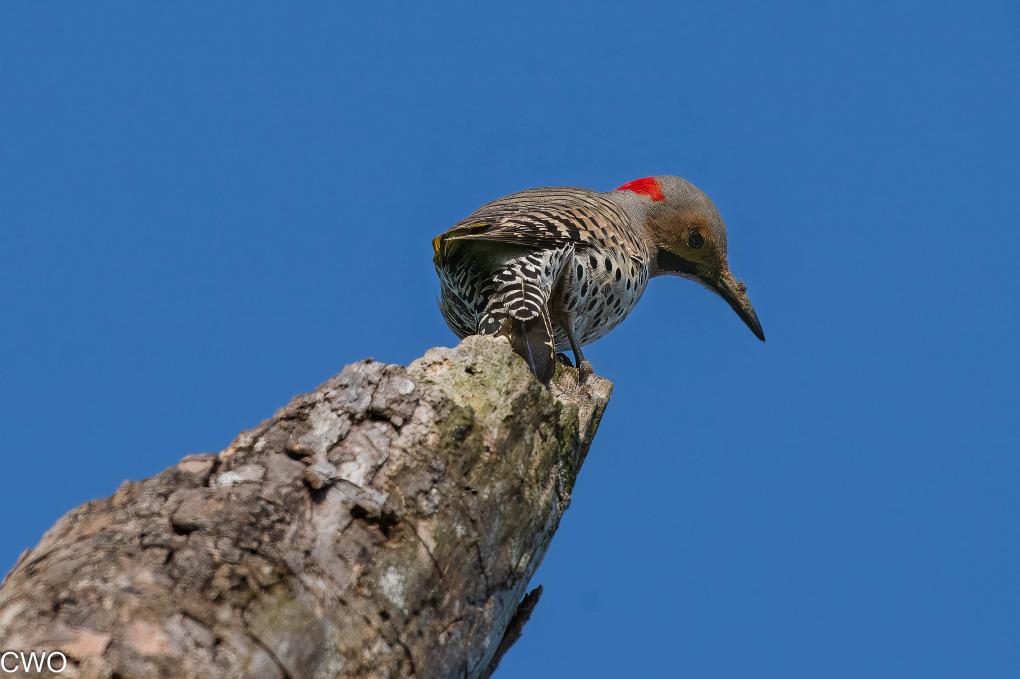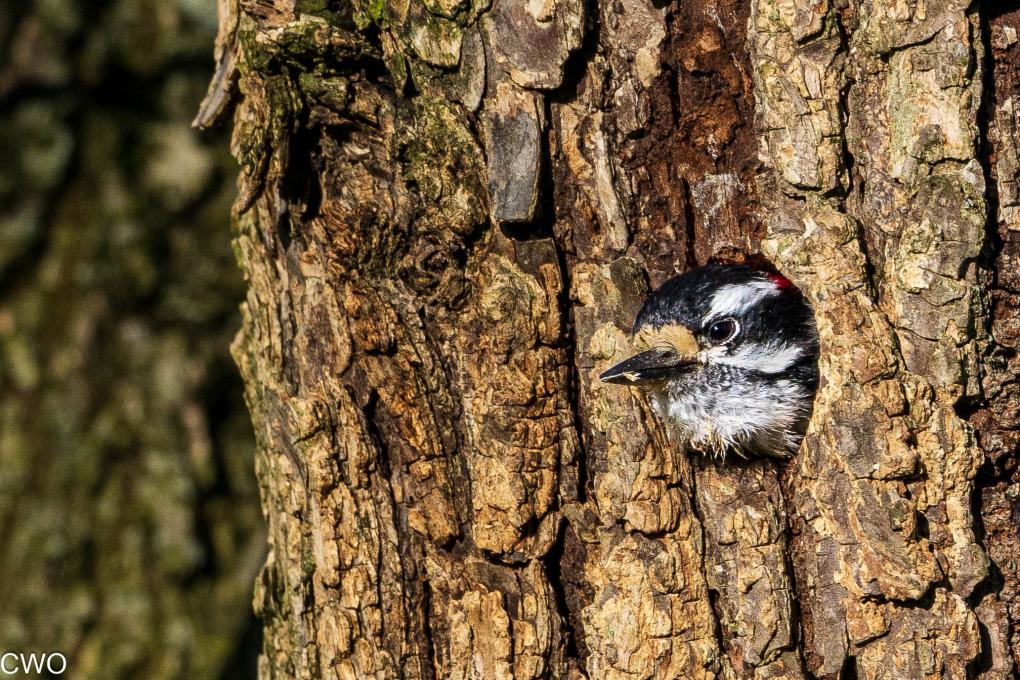The Cornell Lab Bird Academy › Discussion Groups › The Wonderful World of Woodpeckers › How Woodpeckers Rule the World of Wood
-
There are so many different woodpecker tongues.
-
Is the Acorn Woodpecker interested in eating the acorn or the grub that's growing inside the acorn?
-
ElizabethBird AcademyAcorn woodpeckers gather and store acorns to eat the actual acorns later. However, they also eat insects. You can read more about their diet on the All About Birds website.
-
-
I wonder if they can hear an insect inside the gallery.
-
Their tongues and the various barb adaptations depending on their food target.
-
How does somebody chose just one? The long, sticky tongue; curving around the back of the skull, is mind blowing.
-
What I found interesting was woodpecker tongues! I knew that woodpecker tongues could be long, but I didn't know that they were longer than I had thought. I also found it interesting that woodpecker tongue tips could be specialized for what they ate, but it makes sense especially for nectar/sap eaters.
-
The diversity of tongues, how they are used and how they are specialized. I like the idea of the 'paint-brush' tongue among sapsuckers and the barbs used on other woodpeckers to capture food. The keratin on the tip of the tongue was surprising to me. I also was surprised by the different types of pecking and the reasons they peck. I have seen lots of woodpeckers in my backyard and in the forests nearby, but never stopped to consider the way they were pecking. Enjoyed this section very much.
-
I am amazed by a body with a skull, brain and overall size that allows them to use their beak (indirectly head) as a tool without suffering chronic traumatic encephalopathy.
-
I can't pin down even a couple that are my favorite, as every adaptation that woodpeckers possess is admirable to me, from their foot morphology and stiffened rectrices, to their barbed tongue tips that vary from species to species, woodpeckers are just amazing! One thing I feel is worth mentioning is while zygodactyl is the term applied to the orientation of the toes in woodpecker feet, I have also seen the word "ectropodactyl" being thrown around in some literature, such as "The Peterson reference guide to woodpeckers", "Sibley's guide to bird life and behavior", and a paper by evolutionary biologist and ornithologist Walter J. Bock titled "The scansorial foot of the woodpeckers, with comments on the evolution of perching and climbing feet in birds", in which he states that the scansorial foot of the woodpeckers is not a typical zygodactyl foot, but the ectropodactyl foot, in which the second and third toe point forward, while the forth toe is thrust outward laterally, and even at an acute angle to the third toe, while the hallux is either directed downward or lays on its side, functionally useless in aiding the birds resistance to the downward and outward pull of gravity. In the paper, he provides evidence of this assertion, in that the more arboreal woodpeckers, such as those in the genus campephilus, almost have a pamprodactyl-like toe arrangement while hitching up trees, in which the 2nd and 3rd toe point forward, while the 4th toe and hallux are connected via a common sheath of skin at the basal phalanges, and is thrusted outwards, such as in the ivory billed woodpecker. While less arboreal species, such as the northern flicker, have a true zygodactyl arrangement, which he describes as a functional perching or clinging foot. Despite these instances ectropodactyl doesn't seem to have been adopted as the true term to describe the scansorial foot of the more arboreal woodpeckers, and I wonder why it hasn't, as it seems to describe the foot morphology of these groups quite well.
-
I admire the physical adaptations that enable them to stay upright and still while they hammer away at the wood. And, of course, the tongues and what they can do with them.
-
I do have a question regarding one topic in this section. The comments regarding why woodpeckers don’t injure their brains: I don’t doubt that there is no evidence that their skulls have a shock absorbing capability. But adaptation characterizes so much of what we see…note my comments about woodpecker tongues below…I find it hard to believe that there isn’t some adaptation that allows them to do what they do without injuring their brains. The only suggestion offered is brain size. Yes, of course, their brains on a relative scale are smaller than ours but are they smaller than other birds?
-
Their tounges: An wonderful example of adaption...a brush for absorbing sap or bards for pulling insects out of their holes. And their length....that was something I did not knowe beforehand.
-
The tongue being so varied depending on the lifestyle of the bird Cream-coloured Woodpecker Heath River Peru

-
Beautiful image of this woodpecker! Thank you for sharing.
-
-
 Surprising how the Woodpeckers have specialized in eating insects like beetles and larvae that live inside the wood of the trees.
Surprising how the Woodpeckers have specialized in eating insects like beetles and larvae that live inside the wood of the trees. -
Great to see this woodpecker with its prey!
-
-
 How interesting are their feeding techniques and the description of the structure and shapes of their tongues.
Amaizing!
How interesting are their feeding techniques and the description of the structure and shapes of their tongues.
Amaizing! -
Wow! I can see its tongue here. Nice shot.
-
-
I love hearing the different rhythms and sounds they make when they’re pounding on the trees in our yard. Interesting to learn that there are four reasons they peck: communicating, exploring the tree, digging out insects, and excavating a nest. The pileated woodpecker makes a huge holes in our snags. The red- breasted sapsucker makes a tidy row of small holes.
-
The tongue that adapts to make it advantageous to get food.
-
The tongue that wraps around the back of the skull. I've dropped this fact into conversations with non-birders from time to time. They always have to Google it to see if I'm telling the truth.
-
THE SOUNDS THEY MAKE WHEN THEY ARE TAPPING AND DRILLING
-
Their ability to drill and drum and not hurt their heads.
-
Their long ,barbed tongues are amazing! I didn't know this woodpecker fact before starting the course.
-
I totally agree! I had no idea about their tongues before this course, either. Amazing and kind of weird, too... Definitely a fun fact!
-
-
The stiff tail feathers, which create stability.
-
I was unaware of the unique tongue features. Despite having photographed and watched Woodpeckers the tongue are seldom seen.
-


-
The tongue by far is the most amazing adaptation. Just from the length alone and how it curls back into the head is unexplainable, however, necessary when you think of what it does and what it is used for. Also, the barbs and brush like structures at the end of the tongue were rather exciting to learn about.
Read More:

 Surprising how the Woodpeckers have specialized in eating insects like beetles and larvae that live inside the wood of the trees.
Surprising how the Woodpeckers have specialized in eating insects like beetles and larvae that live inside the wood of the trees.  How interesting are their feeding techniques and the description of the structure and shapes of their tongues.
Amaizing!
How interesting are their feeding techniques and the description of the structure and shapes of their tongues.
Amaizing! 
